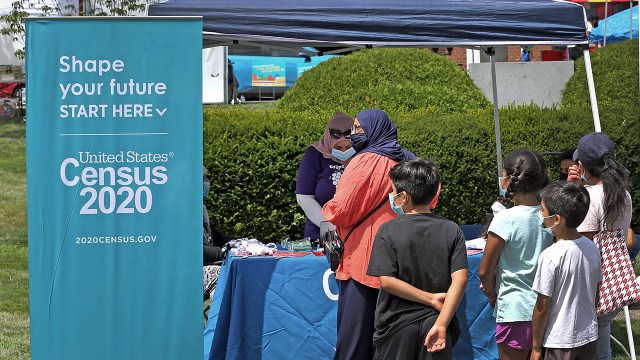
The U.S. Census Bureau has begun planning for the 2030 decennial census, and for the first time, it is asking the public for advice on how to improve its count of all U.S. residents. One big idea the agency already favors – and which may be implemented for other federal surveys, too – is counting most Americans without asking them to fill out a form.

Try our email course on the U.S. census
Learn about why and how the U.S. census is conducted through five short lessons delivered to your inbox every other day. Sign up now!
In a Federal Register notice asking for public feedback by Nov. 15, the bureau especially requests ideas on how to reach population groups that it struggles to count accurately. The bureau’s own research has found that the 2020 census missed millions of people who are American Indian, Black or Latino, as well as young children, while overcounting the White and Asian populations. By some measures, the 2020 count was worse than the previous two censuses.
The census, a once-a-decade snapshot of all U.S. residents, plays a key role in distributing political power and government funding, as well as supplying data for businesses and researchers. It often is described as the government’s largest peacetime mobilization.
This Pew Research Center analysis looks at early plans for how the Census Bureau intends to conduct the 2030 census, focusing mainly on the idea of counting most Americans by using data the government already has (called administrative data or administrative records), rather than requiring them to fill out questionnaires.
We analyzed the Census Bureau’s own request to the public in the Federal Register for advice on how to conduct the 2030 census, as well as material on its website. The post also made use of the bureau’s evaluations of its 2020 census count and its own research on census quality. The post also relies on outside reports about the census, including a Georgetown University study of the uses of administrative records to count people, as well as a Government Accountability Office evaluation that included cost estimates for the census.
The coronavirus pandemic broke out just as the 2020 census was getting underway, leading to disruptions and delays in data collection and publication. Even before it has published all of its 2020 data, the Census Bureau now has a webpage about the 2030 census that includes a timetable, social media toolkit, informational video and frequently asked questions.
When it released a video about planning the 2030 census on Nov. 1, the agency said it had received more than 2,000 responses to its requests for help. Among the suggestions: Use a live chat feature to help people fill out their forms, have people enter their census information while doing their taxes, and provide funding to Native American tribes to let them “count their people.”
The bureau is considering counting most Americans using information the government already has, such as Social Security data, IRS files and other administrative records.
The Census Bureau already has one idea for 2030 that would end its reliance on the increasingly expensive door-to-door census, where the agency sends questionnaires to millions of households and makes personal visits to those who do not respond – more than 50 million households in 2020. The bureau is considering counting most Americans using information the government already has, such as Social Security data, IRS files and other administrative records. The bureau, which has been studying this idea for decades, also is considering acquiring commercial databases, such as credit bureau records.
About one-in-twenty addresses were counted in the 2020 census using government records, which also helped guide census planning and operational logistics. The bureau is planning to expand the use of government records in its largest household survey, the American Community Survey, which releases data each year on a wide range of topics. Beginning in 2024, the agency plans to use property tax records to gather data on land acreage and possibly other topics. And it already uses government files as a source in several other data products, including annual population estimates that rely chiefly on birth, death, immigration and Medicare records.
A key reason for relying on government records instead of surveys is to ask less of respondents at a time when survey researchers are finding it harder to reach people to answer their polling questions. Using existing government records saves money compared with sending and collecting millions of questionnaires. Research has found that when people leave census survey answers blank, government records likely are more accurate than asking neighbors, landlords or other “proxy” respondents to provide missing information.
Possibly 90% or more of U.S. residents could be counted accurately using government records. Yet, Pew Research Center surveys show that some Americans (though not a majority) do not trust the government to keep their information safe or have other doubts about the census.
Possibly 90% or more of U.S. residents could be counted accurately using only IRS and Social Security records, according to research cited in a report commissioned by the bureau. The agency also has researched Americans’ attitudes about using administrative records instead of a survey. Its statements about administrative data mention that the bureau is required by law to obtain and reuse data from other agencies. Yet, Pew Research Center surveys show that some Americans (though not a majority) do not trust the government to keep their information safe or have other doubts about the census.
Even if it ends up being used more widely, government data is likely to miss certain groups, including people of some races or ethnicities, immigrants, young children, people who moved recently and those without jobs or who are underemployed, according to researchers – the same groups the Census Bureau already has trouble counting accurately.
Census Bureau Director Robert Santos says that greater use of existing government data would conserve agency resources for the more difficult job of counting the hardest-to-reach Americans. The 2020 census spent an estimated $96 per household, up from $92 in 2010, according to the Government Accountability Office.
The bureau’s Federal Register notice also seeks advice on user-friendly technology, new data sources and how to contact potential respondents and help them fill out their questionnaires.



